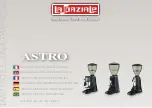
S1 Dream-T Espresso Machine
Owner’s Manual
Page 7
Steaming Milk - Basics
First, le
t‟s talk about some of the things you need to learn in order to become „
barista-like
‟ in
your techniques.
Milk
– Whole milk works best to steam, both in technique and in flavor! Lower fat milks contain
mostly water which will not foam well and will be almost tasteless when steamed. After all your
hard work you will be left with a less than desirable tasting beverage.
Temperature
– Your whole milk needs to be as cold as possible to ensure the creamiest,
sweetest, and best tasting micro-foam. Once the milk has reached a temperature between
150-160 degrees, you must stop the process. The longer amount of time you have with the
cold milk gives you that extra time to continue making the milk creamy and sweet tasting. Milk
heated above 160 degrees will be burnt and taste terrible.
Frothing Pitcher
– The size of your pitcher is relative to the size and number of drinks you will
be preparing at the time. Our recommendation on pitcher choices would be our own
“Pro
Barista Steaming Pitcher”
which has become the pitcher of choice of the renowned baristas
who helped train Chris‟ Coffee Service in this frothing technique. These baristas felt the Pro
Barista Steaming Pitcher promoted a user friendly rolling of the milk which made it simple to
create thick rich micro-foam for pouring Latte Art.
Amount of Milk
– Too little milk in your frothing pitcher will cause splashing when you turn on
the steam arm; too much milk will cause overflow and make a huge mess. The pitcher must
be filled between 1/3 to 1/2 full to have the maximum capacity for properly steaming milk. If
your pitcher has a spout, fill it to half an inch below where the spout starts.
Stretching the milk
– Refers to the initial heating of the milk and the forceful introduction of air.
Stretching continues until the milk reaches an approximate temperature of 100 degrees or
“body temperature”
Texturizing the milk
– Refers to the next phase of frothing whereby the steam wand is
submerged in the milk and the pressure continues to roll the milk. This process breaks down
the large air bubbles into tiny air bubbles which then creates the smooth and creamy
texture
that is most desirable.
Note
– It is highly recommended to steam your milk before pulling your shot. It is also
recommended to not use a steaming pitcher that is larger than 20oz for optimal performance.






























